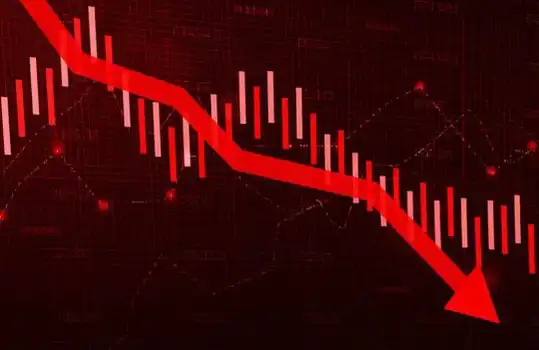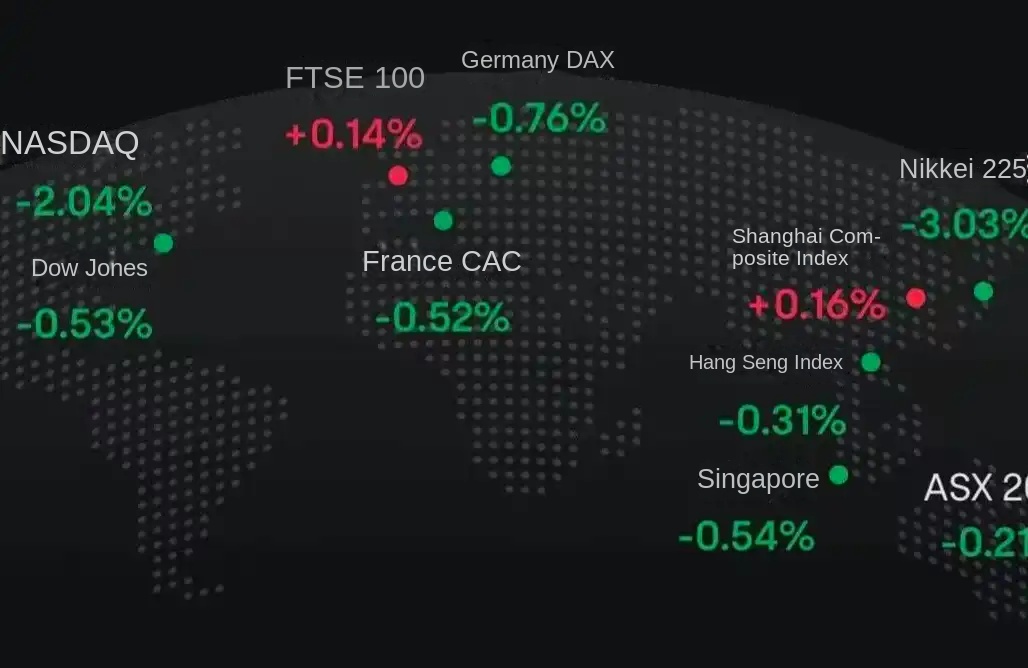Why Does the Price of Bitcoin Rise When the US Government Shuts Down?
The U.S. Government Shutdown has officially entered its record-breaking 36th day.
Over the past two days, global financial markets have experienced a sell-off. The Nasdaq, Bitcoin, tech stocks, the Nikkei Index, and even safe-haven assets like U.S. Treasuries and gold have not been spared.
Fear has gripped the markets, while Washington politicians continue to bicker over the budget. Is there a connection between the U.S. Government Shutdown and the global financial market downturn? The answer is becoming clear.
This is not a typical market correction but a liquidity crisis triggered by the government shutdown. With fiscal spending frozen, hundreds of billions of dollars are locked up in the Treasury's accounts, unable to flow into the market, disrupting the financial system's circulation.

The Treasury's "Black Hole"
The U.S. Treasury General Account, known as the TGA, can be understood as the U.S. government's central checking account at the Federal Reserve. All federal revenues, whether from taxes or the issuance of Treasury securities, are deposited into this account.
Similarly, all government expenditures, from paying civil-servant salaries to defense spending, are disbursed from this account.
Under normal circumstances, the TGA functions as a fund's transit station, maintaining a dynamic balance. The Treasury receives money and promptly spends it, channeling funds into the private financial system, turning them into bank reserves, and providing liquidity to the market.
The government shutdown has disrupted this cycle. The Treasury continues to receive money through taxes and bond issuance, causing the TGA balance to swell. However, because Congress has not approved a budget, most government agencies are shut down, and the Treasury cannot spend as planned. The TGA has become a financial black hole of inflows only.
Since the shutdown began on October 10, 2025, the TGA balance has expanded from around $800 billion to over $1 trillion by October 30. In just 20 days, over $200 billion have been drained from the market and locked in the Federal Reserve's vault.

U.S. Government's TGA Balance | Image Source: MicroMacro
Analysts suggest that the government shutdown has sucked nearly $700 billion in liquidity out of the market within a month. This effect is on par with multiple rounds of Fed rate hikes or accelerated quantitative tightening.
When the reserve of the banking system is heavily siphoned by the TGA, both the ability and willingness of banks to lend are significantly reduced, causing a sharp increase in the market's funding cost.
The first to feel the chill are always those assets most sensitive to liquidity. The cryptocurrency market plummeted after the shutdown on October 11, with the liquidation scale approaching $20 billion. This week, tech stocks are also on shaky ground, with the Nasdaq index falling 1.7% on Tuesday, plummeting after Meta and Microsoft's earnings reports.
The global financial market's decline is the most tangible manifestation of this invisible tightening.
The System is "Running a Fever"
The TGA is the "cause" triggering the liquidity crisis, and the soaring overnight repo rate is the most direct symptom of the financial system "running a fever."
The overnight repo market is where banks lend short-term funds to each other, acting as the capillaries of the entire financial system. Its rate is the most authentic indicator of how loose or tight the banks' "money tap" is. When liquidity is ample, interbank borrowing is easy, and rates are stable. However, when liquidity is drained, banks start to run short on cash and are willing to pay a higher price to borrow money overnight.
Banks are Running Out of Cash
Two key indicators clearly show how severe this high fever is:
The first indicator is the SOFR (Secured Overnight Financing Rate). On October 31, the SOFR surged to 4.22%, marking the largest single-day increase in a year.
This rate is not only higher than the Federal Reserve's target range of 4.00% for the federal funds rate, but it also exceeds the effective federal funds rate by 32 basis points, reaching the highest level since the market crisis in March 2020. The actual borrowing cost in the interbank market has spiraled out of control, far surpassing the central bank's policy rate.

Secured Overnight Financing Rate (SOFR) Index | Source: Federal Reserve Bank of New York
The second, even more astonishing indicator, is the Federal Reserve's SRF (Standing Repo Facility) usage. The SRF is an emergency liquidity tool provided by the Federal Reserve to banks. When banks cannot borrow money in the market, they can pledge high-grade bonds to the Fed in exchange for cash.
On October 31, the SRF usage surged to $50.35 billion, setting a record high since the pandemic crisis in March 2020. The banking system is now in a severe dollar shortage, having to resort to the Fed's last-resort window.

Sudden Repurchase Facility (SRF) Utilization | Source: Federal Reserve Bank of New York
Debt Default
The overheating of the financial system is currently transmitting pressure to the vulnerable sectors of the real economy, triggering long-dormant debt landmines. The two most dangerous areas at the moment are commercial real estate and auto loans.
According to data from research firm Trepp, the default rate for U.S. office CMBS commercial real estate mortgage-backed securities reached 11.8% in October 2025, setting a new historical high that even surpassed the peak of 10.3% during the 2008 financial crisis. In just three years, this number skyrocketed nearly 10 times from 1.8%.

US Office CMBS Commercial Real Estate Mortgage-Backed Securities Default Rate | Source: Wolf Street
The Bravern Office Commons in Bellevue, Washington, is a typical case. This office building, once fully leased by Microsoft and valued at $6.05 billion in 2020, has now plummeted by 56% to $2.68 billion following Microsoft's departure and has entered into default.
The most severe commercial real estate crisis since 2008 is spreading systemic risk throughout the entire financial system through regional banks, Real Estate Investment Trusts (REITs), and pension funds.
On the consumer side, alarms are also sounding for auto loans. With new car prices soaring to an average of over $50,000, subprime borrowers are facing interest rates as high as 18-20%, heralding an approaching wave of defaults. As of September 2025, the default rate for subprime auto loans has risen to nearly 10%, and the overall auto loan delinquency rate has grown by over 50% in the past 15 years.
Surging Electricity Costs
Meanwhile, the surging energy prices are becoming another straw that breaks the camel's back for many households. In the backdrop of high inflation, the rise in electricity costs is particularly deadly. Since the beginning of 2025, the average household electricity bill in the U.S. has risen by over 11%.

U.S. Average Electricity Price (USD per Kilowatt-hour)|Source: Federal Reserve Bank of St. Louis (FRED)
In Florida, 63-year-old wheelchair user Al Salvi's monthly electricity bill has approached $500. "We now have to choose between paying the electric bill and buying medication," he helplessly told NPR in October.
This energy crisis, caused by multiple structural issues such as grid aging and AI-driven surges in electricity demand, is compounded by interest rate and debt issues, pushing ordinary American households to the brink of financial collapse.
From the Fed's stealth tapering to the overnight rate's systemic fever, and from the widespread disarray in commercial real estate, auto loans, and household energy bills, a clear crisis transmission chain has emerged.
The spark unexpectedly ignited by the Washington political deadlock is now detonating the pre-existing structural weaknesses within the U.S. economy.
Labor Market "Deterioration"
A deeper crisis is also brewing in the labor market, as the U.S. government shutdown not only drains liquidity from the market but also deprives the Federal Reserve of the most critical guidance for monetary policy: economic data.
Until the deadlock is resolved, key official economic data, including the monthly jobs report and CPI inflation data, will be suspended. This means that at a critical inflection point in the economy, the Fed's decisions will lack the most authoritative guidance.
Amid the data void, the market is forced to turn to alternative data from the private sector. The September ADP employment data, known as the "mini nonfarm payroll," released on October 1st, showed a decrease of 32,000 jobs in the U.S. private sector, marking the first consecutive negative growth in this data since the pandemic began.

U.S. ADP Nonfarm Employment Figures from October '23 to September '25|Source: MicroMacro
In the last official employment data released in August before the shutdown, only 22,000 new jobs were added, with historical data significantly revised downward by 911,000 jobs.
During the post-pandemic economic recovery period, the monthly new job additions in the United States usually ranged between 200,000 and 300,000. However, it has now plummeted to 20,000, and even shown negative growth, indicating that the labor market has entered a state of stagnation or contraction. More concerning is the significant downward revision of historical data, suggesting that the job market over the past year was actually much weaker than officially reported.
Although the Federal Reserve cut interest rates by 25 basis points as scheduled during their October 31st meeting, the language in their statement has shifted from the previous "strong labor market" to "the downside risks facing employment have been rising." Atlanta Fed President Bostic went as far as to directly warn in his post-meeting speech that employment risks have been steadily increasing since August.
These expressions indicate that the Fed's concerns about the labor market are intensifying, and reality is confirming these concerns. Amazon announced layoffs of thousands, UPS cut management positions, and what was once considered a stable job market with a "no hire, no fire" policy is now shifting towards a wave of layoffs. The tech industry, after experiencing large-scale layoffs in 2023-2024, has seen recruitment almost come to a standstill in 2025. Industries such as retail, logistics, and financial services have also been reporting layoffs.
Historical experience has repeatedly shown that a rapid increase in the unemployment rate is often a precursor to an economic recession. When the job market shifts from prosperity to contraction, a wave of corporate layoffs begins to spread, consumer confidence collapses, and an economic recession often follows. If the current trend of deteriorating employment continues, the U.S. economy may face systemic risks more severe than a liquidity crisis — an economic recession.
How Are Traders Viewing the Outlook?
How long will this liquidity crisis persist? Traders have diverging views on this question. While they generally acknowledge the current liquidity squeeze, they hold different opinions on the macro trend for the next six months.
The pessimists represented by Mott Capital Management believe that the market is facing a liquidity shock comparable to the end of 2018. Bank reserve levels have dropped to dangerous levels, very similar to the conditions during the market turmoil caused by the Fed's balance sheet reduction in 2018. As long as the government shutdown continues and the Treasury General Account (TGA) keeps draining liquidity, the market's pain will not end. The only hope lies in the Quarterly Refunding Announcement (QRA) that the Treasury Department is expected to release on November 2nd. If the Treasury Department decides to lower the TGA's target balance, it may release over $150 billion in liquidity to the market. However, if the Treasury Department maintains or even raises the target, the market's winter will become even longer.
The optimists, represented by renowned macro analyst Raoul Pal, have put forward an intriguing theory called the "painful window." He acknowledges that the current market is in a painful window of liquidity squeeze but firmly believes that a deluge of liquidity will follow. In the next 12 months, the U.S. government has up to $10 trillion in debt to roll over, forcing it to ensure market stability and liquidity.

31% of U.S. government debt (about $7 trillion) will mature in the next year, combined with new debt issuance, the total amount could reach $10 trillion | Source: Apollo Academy
Once the government shutdown ends, the pent-up hundreds of billions of dollars in fiscal spending will pour into the market like a flood, and the Fed's Quantitative Tightening (QT) will also technically end, possibly even shifting.
To prepare for the midterm elections in 2026, the U.S. government will stimulate the economy at all costs, including rate cuts, easing bank regulations, and passing cryptocurrency bills. Against the backdrop of continued liquidity expansion in China and Japan, the world will see a new round of liquidity flooding. The current pullback is just a shakeout in the bull market, and the real strategy should be to buy on the dip.
Mainstream institutions like Goldman Sachs and Citigroup hold a relatively neutral view. They generally expect the government shutdown to end in the next one to two weeks. Once the deadlock is broken, the huge amount of cash locked in the TGA will be rapidly released, easing market liquidity pressures. However, the long-term direction still depends on the Treasury Department's QRA announcement and the Fed's subsequent policies.
History seems to be repeating itself. Whether it was the balance sheet reduction panic of 2018 or the repo crisis in September 2019, they all ended with the Fed's surrender and re-injection of liquidity. This time, facing the dual pressures of political deadlock and economic risks, policymakers seem to have once again come to a familiar crossroads.
In the short term, the fate of the market hangs on the whims of Washington politicians. But in the long term, the global economy seems to be deeply trapped in a cycle of debt-liquidity-bubble from which it cannot extricate itself.
This crisis, triggered unexpectedly by the government shutdown, may only be a prelude to the next round of a larger-scale liquidity frenzy.
Welcome to join the official BlockBeats community:
Telegram Subscription Group: https://t.me/theblockbeats
Telegram Discussion Group: https://t.me/BlockBeats_App
Official Twitter Account: https://twitter.com/BlockBeatsAsia


 Forum
Forum Finance
Finance
 Specials
Specials
 On-chain Eco
On-chain Eco
 Entry
Entry
 Podcasts
Podcasts
 Activities
Activities
 OPRR
OPRR









